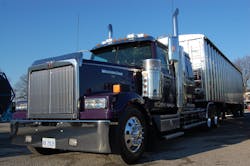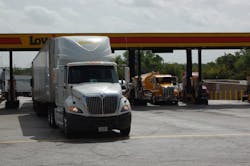Is the glass half-full or half-empty for trucking?
You’d be forgiven for thinking that up is down and down is up in this topsy-turvy trucking market of late.
Freight volumes are down and so many shippers feel now is the time to wring rate cuts from their motor carriers – even as the ongoing driver shortage and a host of near-term regulations will converge to create in the words of John Larkin, managing director and head of transportation capital markets research at Stifel Financial Corp., “a one-two – and three, four five, six – Muhammad Ali punch to truckload capacity.”
But before we get there, let’s take a look at the lay of the trucking land.
For starters, from a “big picture” perspective at least, the economic outlook for the U.S. looks pretty rosy on the whole – though truckers can be forgiven for feeling it to be otherwise (we’ll get to that in a minute).
According to an economic outlook issued by TD Economics – an arm of TD Bank – last week, the American economy is “showing its resilience, bouncing back with gusto after a slow start to the year,” explained Beata Caranci, the company’s chief economist.
"Consumers burst out of the gates in the second quarter, providing a strong impetus to economic growth," Caranci said. "Supported by accommodative interest rates and rising wages, consumer spending and housing investment will continue to lead economic growth over the second half of this year and into 2017."
With this backdrop in place, job growth is likely to re-accelerate in the months ahead, pushing unemployment to a new low and providing greater full-time job opportunities to those who want them. A
As a result, TD Economics projects U.S. economic growth of 1.9% in 2016 and 2.1% in 2017, enough to bring the unemployment rate down from its current level of 4.7% to 4.3% by the end of 2017.But then you have to think … U.S. economic growth will barely average 2% over the next couple of years? And that’s cause for cheering? That’s why stories like this one put such economic growth forecasts in a far harsher light.
Then there’s the “unemployment rate” debate, for while the overall number looks good, it’s being heavily skewed by a far more worrisome trend: the overall labor participation rate is falling and fewer men are working. Those are not good signs.
Indeed, Michael Baudendistel, vice president at Stifel, recently noted that “there is greater risk to the downside than upside in our estimates when considering the likelihood that the [trucking] industry will produce near historical cyclical trough levels at some point in the next few years.”
Stifle so far assumes a “continuation of uninspiring” U.S. gross domestic product (GDP) growth of 2% through 2018, though at this point in the economic cycle, “we believe the potential for a recession in the next three to four years is increasingly likely; if that occurs before 2018, our [GDP] estimates will almost certainly be too high.”
Not exactly what one would call heartening words.
When we turn to the freight markets, similar less-than-perky trends abound.
TL carrier Werner Enterprises for one noted this week that its second quarter earnings are going to dip down to between 21 and 25 cents a share, due to a range of issues:
- Sluggish freight market conditions resulting in decelerating freight rates per total mile trends;
- Those conditions are being exacerbated by “difficult” 2016 customer rate negotiations, weak spot market rates, lower miles per truck and increased empty miles;
- Driver pay increases implemented in the first quarter of 2016 and independent contractor per mile pay increases in fourth quarter last year are raising bottom-line costs for Werner
- A soft used truck market.
Indeed, Stifel’s Baudendistel noted that used truck prices are down 10% from 2015 and are expected to fall further.
“And with the prices on new tractors continuing to increase, as OEMs continue to receive some pricing gains and as more high-cost safety and technology-related components are added to the new models, the percentage of the cost of a new tractor – which is made up for by the sale of a used tractor – will likely continue to decrease, making it more difficult for companies, especially small fleets, to purchase new equipment in large numbers; especially in an environment where fleets are not growing significantly, and demand for new equipment is largely for replacement, as we have seen recently,” he said.
Still, it’s not completely a wash for trucking, as comments made by Bob Costello, chief economist with the American Trucking Associations (ATA) trade group, in a sit-down with Stifel’s Larkin last week illustrate.
Here are some of Costello’s thoughts:
- Truck freight volumes weakened considerably through 2015 and growth this year will remain uneven by sector and weak, with the contract freight market soft and the spot market very weak.
- The combination of more trucks and soft demand loosened industry capacity, yet tractor counts remain well below all-time highs.
- Thus expect capacity to tighten going into 2017, as freight volumes recover and the implementation of the electronic logging device (ELD) mandate nears.
- Fleets will continue to experience rising costs, excluding fuel. Note: any fuel savings gained by carriers last year was used to pay drivers more, replace trucks, and add trailers.
- The combination of pay increases and oil field weakness helped with the driver shortage, but the long-term trend still points to an undersupply of drivers – indicating trucking capacity will still be constricted.
So … is the glass half-empty or half-full for trucking? It’s still hard to say. We’ll dig into more trends tomorrow to see if we find an answer to this question.

